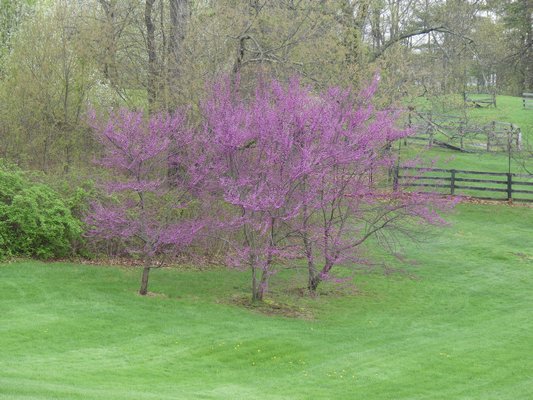

It’s been a lush spring and, despite how cold it’s been in May after a record warm April, the gardens are lush, the lawns are green, and it’s been a great time for planting. So, a bonus and a second ramble this month to catch up on a few items.When I add new perennials to my garden, I always plant them in groups of three or more. If the plants do well, I inevitably plant more the following year. But with more than 700 varieties of perennials in my garden, it’s a little difficult to find the time to keep track of them, so there are occasions when a plant group or specific plant gets lost.
Several years later, I’ll stumble on the plant or label that remains and make notes like “buy more!” If it’s early enough in the season, I go back to my database and try to find out when I did the planting, where I bought the plants and who the grower was. When this process works, it’s great. But when it doesn’t, it’s very frustrating.
One plant that I really like and tried to find for more planting last summer is the Prairie Winecup, or Callirhoe involucrata. It’s native to New Mexico, and I find that it does really well in one of my sunny, dry spots. It may also be an interesting plant for you if you’ve got a sunny, dry spot where you need an interesting flowering perennial.
I originally had three, but I was down to one and had no clue where it came from. All I had was a database entry and the plastic tag that was still in the garden several years later. Couldn’t find anyone who carried it or had it in stock, but I did find it at High Country Gardens (highcountrygardens.com) in Santa Fe, and that’s probably where the original plants came from. Last week, I was able to order five more: Placed the order on Monday, shipped on Thursday, and at my door on Friday. Now, that’s how it should work!
But I wasn’t so lucky with two other plants. I’d planted a number of Epimediums several years ago, and all but one died out. Not good—but the one that did survive was a winner, and I wanted more of it.
This one is Epimedium Dark Beauty. This time, my database actually paid off, because it told me when I bought it (2013), where I bought it (Lynch’s), the pot size, the price and the grower (Glover).
So, I go to Lynch’s and ask if they can get any. Nope … Glover doesn’t have any, can’t get any, and maybe, possibly, will have them next year. No other garden center or grower I could contact had any.
So either someone has cornered the market and bought up all the stock for a project, the plant was an utter failure in all but my garden, or the supply chain is choked up somewhere.
Same story with Heuchera Mystic Angel. This is a really nice heuchera that overwinters really well and colors up very early in the spring for a nice foliage display from early April through the spring and summer. I originally had three but could find only two.
Back to the database. Bought them at Lynch’s in 2013. They were grown by Sunny Border Nurseries in Connecticut. Hoping they are available, but so far no word. I was able to divide the existing plants, though, so maybe I’ll get lucky.
Not sure what the solution to this dilemma is. I just hope the answer isn’t that breeders and distributors are manipulating the market—but it sure indicates that knowing how to propagate your own plants can come in handy. More on this later in the year.
I’m the official shopper for the Messinger family, so at least once a week I’m in the supermarket. In April, one of the items on my list was parsley. I was in the produce section at the market, and there was a choice between cut bunches of parsley and a display of potted, sleeved fresh parsley plants. The cost was similar—so why not buy they potted parsley, cut as much as we need, then let it grow more? The prices were nearly identical, and the potted parsley was organic, the cut bunch probably not.
Get the potted parsley home, and within hours it’s wilted. Not a disease, not an insect. Turns out these plants were being grown on capillary mats, which is a very wet-to-moist mat under the pot. The parsley roots grow down to the mat and, like a hydroponically grown plant, they just soak up the water as needed. But when you take the plant home, you have no clue, unless you notice the mass of roots coming from the bottom of the pot.
My simple solution was to put the pot in a plastic saucer and just leave water at the bottom of the saucer once a day. The parsley soaks it up and is thriving just a few feet from a sunny window. It’s been at home for nearly two months now but still being happily productive.
I’ve also seen basil being grown like this, and a few other herbs, so if you buy this in the grocery, just remember to water from the bottom and not the top.
I get comments and questions every spring about a really attractive shrub, Cercis Canadensis, or the Eastern redbud. It flowers at about the same time or slightly earlier than dogwoods, but with its profusion of small purple flowers, this shrub stands out and can be quite spectacular. Planted singly or in small groups of three to five, they can give amazingly colorful displays at a woods’ edge or as specimen plantings.
You can buy them at garden centers, or smaller plants and starts online, but I’ve found they are best planted small and left to fill in, as they can be finicky transplanters. The flowers last from two to four weeks (in springs like this, four weeks), and then the foliage fills in, followed by small seed pods in the fall.
With a range from Florida up into hardiness zone 4, the tree grows naturally as an understory plant in mixed deciduous forests. The French Canadian settlers are said to have added the flowers to salads and in making pickles, and even with cooked vegetables. Not sure how they worked them into pickles, since that’s much later in the summer, but that’s what the books say. There a white “alba” variety, but that kind of defeats the purpose of a redbud.
In addition to issues with deer, voles and chipmunks, I’ve been daunted by rabbits. I let my dog chase them, knowing she’ll never catch one, and hoping it will make them more cautious—but she’s bored with them, and they seem to know that.
So, before my emerging plants got too tasty for them to resist, I tried a product called Rabbit Scram. It’s a granular material (made by the same company makes Deer Scram, Mole Scram and some other repellents that I can’t vouch for), and it contains dried blood, white pepper, garlic, cloves and meat meal. A 2.5-pound jar costs about 20 bucks and, according to the directions, it can protect about 1,300 square feet for 30 days or more. So, I tried it as a barrier around my large perennial bed and test gardens. So far, so good. Rabbits to the east, rabbits to the west, but not a nibble at my place … so far.
It will get warmer, stay warmer, and it will get sunnier. Looking like an average summer for temperatures and rainfall. But it’s been great weather for slugs, and they’re around, so start your treatments now or you’ll be very sorry later.
Keep up the good work, and keep growing!
 More Posts from Andrew Messinger
More Posts from Andrew Messinger